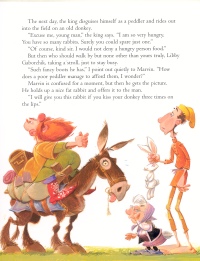| ________________
CM . . .
. Volume XIV Number 5 . . . . October 26, 2007
An unconventional fairy, Libby Gaborchik, addresses readers with her demand gaze and shares her thoughts about the headline in the “Once Upon a Times” newspaper that she visually shares with readers. Although the headline states that Princess Vera is deathly ill, Libby assures readers that the dear girl’s problem is simply that she is “starved for love.” Libby continues:
News of the cure to the princess’s ailment spreads throughout the kingdom. Young men wait in long queues, but their three peaches do not meet the criterion of “perfect.” In a nearby cottage live three brothers and their poor mother. Each son decides to fulfill the quest and marry the princess. On his journey to the castle with his three peaches, the oldest son meets Libby, and his rudeness to the fairy results in his fruit being transformed to serpents. The second son departs for the castle, and he, too, encounters Libby in the forest. His peaches are changed to toads as a consequence of his discourtesies toward the fairy. Finally, Marvin, the youngest son, embarks on his journey telling his mother that not only will he save and marry the princess but that he will bring his mother to live with him in the castle. When Marvin meets Libby in the forest, his kindness and honesty to the fairy are rewarded. She transforms his three “not-so-great” peaches into perfect peaches and gives Marvin a silver whistle because it may “come in handy.” Of course, once Princess Vera consumes the perfect peaches, she becomes well again, and Marvin asks permission to wed the King’s daughter. But the King views Marvin as a pauper and does not want him to marry Princess Vera. Therefore, the monarch assigns Marvin a test … to collect the 100 rabbits that roam the courtyard so that the cook can prepare a rabbit stew to celebrate Vera’s good health. Similar to the Pied Piper of Hamelin, Marvin uses the silver whistle to assist him in gathering the rabbits. The monarch is furious and under the pretense of the rabbits’ needing additional grazing time to become plumper for the stew, he twice more requires Marvin to assemble the 100 hares. The Queen and then the King attempt to trick Marvin as he gathers the rabbits, but with the assistance of Libby, Marvin recognizes the deception, and ultimately it is he who dupes the royal couple. Thus, through courtesy and honesty, and with the assistance of an unconventional fairy and a silver whistle, Marvin marries Princess Vera!
Bar-el’s adaptation of “Three May Peaches,” a French folktale, reflects original elements but also includes unique elements. The tale is told from the point of view of Libby, and her narrative voice contributes to the humour of the book. Such a Prince exhibits many structures of classic fairy tales such as three characters, three tasks, rude and dishonest characters receiving their comeuppance, magic, and a “happy” ending for the protagonist. The tabloid-like cover establishes the comical nature of the book, as do the endpages with hyperactive hares hopping about as a disconcerted cook peers into his pot. According to the publisher’s information, Manders enjoys researching historical periods for his illustrations, and details of Russia during the time of the czars are evident throughout Such a Prince. Highly Recommended. Sylvia Pantaleo teaches courses in Language Arts in the Faculty of Education, the University of Victoria.
To comment on this
title or this review, send mail to cm@umanitoba.ca.
Copyright © the Manitoba Library Association. Reproduction for personal
use is permitted only if this copyright notice is maintained. Any
other reproduction is prohibited without permission.
NEXT REVIEW |TABLE OF CONTENTS FOR THIS ISSUE
- October 26, 2007. AUTHORS
| TITLES | MEDIA REVIEWS
| PROFILES
| BACK ISSUES
| SEARCH | CMARCHIVE
| HOME |

